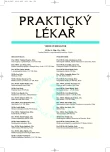-
Medical journals
- Career
Initial experience using a laser-balloon endoscopic catheter for the treatment of patients with paroxysmal atrial fibrillation
Authors: J. Škoda 1; P. Neužil 1; V. Y. Reddy 2; J. Petrů 1; L. Šedivá 1; M. Táborský 1; A. Raviele 3; S. Ernst 4; K. H. Kuck 4; A. Natale 5
Authors‘ workplace: Kardiologické oddělení Nemocnice Na Homolce, Praha 1; Massachusetts General Hospital, Boston, USA 2; Umberto Hospital, Venice, Itálie 3; St. Georg Hospital, Hamburg, Německo 4; Cleveland Foundation Hospital, Cleveland, USA 5
Published in: Prakt. Lék. 2007; 87(10): 618-623
Category: Of different specialties
Overview
Background:
During catheter ablation of atrial fibrillation (AF), placing contiguous point ablation lesions to electrically-isolate the pulmonary veins (PV) can be technically challenging. A novel balloon catheter (Endoscopic Ablation System – EAS; Cardiofocus, Inc.) which utilizes a miniature endoscope for real-time visualization during ablation has been developed. This system employs arcs of light-energy that are adjustable (rotating, advancing, retracting) independent of the balloon to direct energy to the pulmonary veins PV-left atrium(LA) region. This report details the first clinical long-term follow-up results from a prospective multicentric trial in patients from our center.Methods:
22 patients with a history of symptomatic drug-resistant paroxysmal AF were studied: Sex: M/F = 19/3; Age 53 ± 8 years (29–73); AF duration: 7.0 ± 3.0 years (1–14); LA diameter: 42 ± 4 mm (33–49); left ventricular ejection fraction (LVEF) 68 ± 4% (45–77). A single treatment consisting of isolation of the PV ostia was delivered using the EAS. There were no exclusion criteria related to morphology/number of PVsResults:
During long-term follow-up 17.1 ± 6.6 months (7–27) AF free endpoint was achieved in 19 (86.3%) patients, of whom 7 (33 %) patients needed adjunctive betablocker and/or propafenon. Three patients (13.6 %) experienced AF despite antiarrhythmic therapy, the procedure was successfully repeated in one patient. During 6 to 12 moths follow-up visits, a computed tomography revealed only mild stenosis 26.4 ± 4,4 % (20–37) in 16 % of PVs. Two adverse events were documented: transient ischemic attack, and pseudoaneurysm of a right femoral artery solved by a percutaneous glue-tissue application. The time of procedure + fluoroscopy significantly decreased during a learning curve.Conclusion:
This initial clinical-feasibility study suggests that a single treatment with the EAS of paroxysmal AF appears safe and efficacious.Key words:
paroxysmal atrial fibrillation, catheter ablation, transseptal puncture, pulmonary vein isolation, light-energy laser arc.
Labels
General practitioner for children and adolescents General practitioner for adults
Article was published inGeneral Practitioner

2007 Issue 10-
All articles in this issue
- Diabetes, pre-diabetes and cardiovascular diseases
- Pneumothorax. Overview and current therapeutic options.
- Hemochromatosis – a current review
- Prion diseases in humans
- Urological complications of gynaecologic surgery
- Tumour of the hands
- Regulation of bone cell metabolism at the cellular and molecular level
- Posttraumatic stress disorder (PTSD)
- Initial experience using a laser-balloon endoscopic catheter for the treatment of patients with paroxysmal atrial fibrillation
- Colorectal cancer and inflammatory bowel diseases.
- Progressive heart failure due to cardiac amyloidosis
- General Practitioner
- Journal archive
- Current issue
- Online only
- About the journal
Most read in this issue- Urological complications of gynaecologic surgery
- Pneumothorax. Overview and current therapeutic options.
- Posttraumatic stress disorder (PTSD)
- Hemochromatosis – a current review
Login#ADS_BOTTOM_SCRIPTS#Forgotten passwordEnter the email address that you registered with. We will send you instructions on how to set a new password.
- Career

